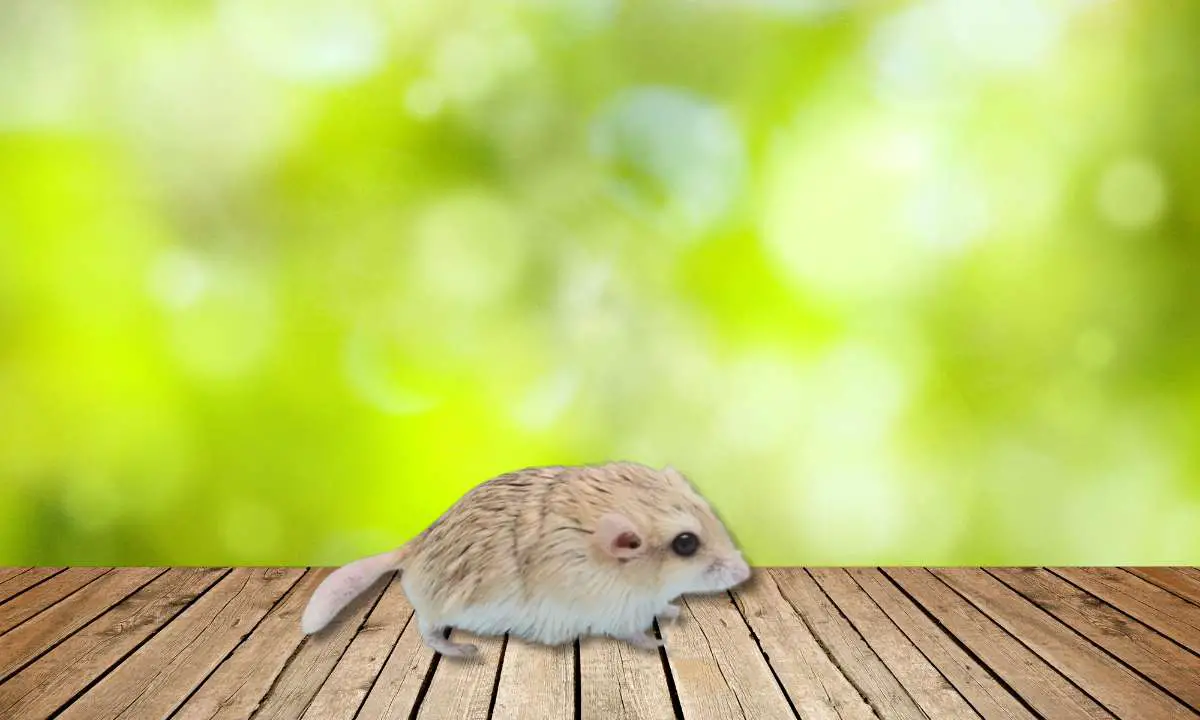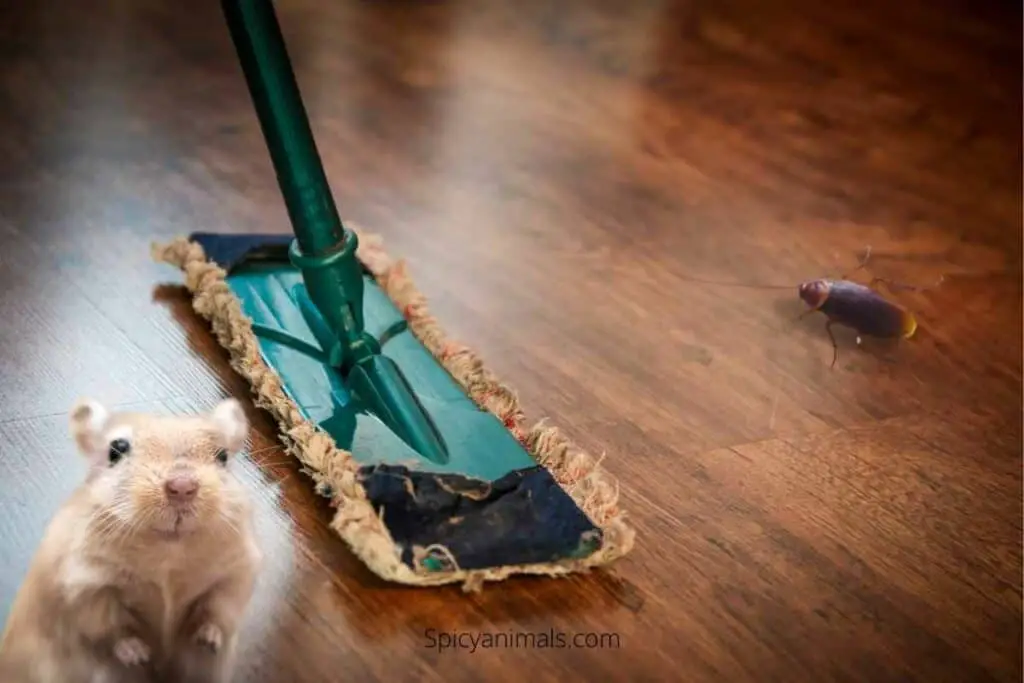Ever looked at a fat-tailed gerbil and thought, ‘Why so chubby, buddy?’ Well, it’s not just cute fluffiness – these gerbils are desert survivors with a unique adaptation! Keep reading to discover the fascinating characteristics of these adorable, plump-tailed critters.”
Unlike other gerbils that have long, thin tails, fat-tailed gerbils have large, plump tails that store fat reserves to help them survive in their arid natural habitat. They also have thick fur and a stocky build that sets them apart from other species.
In this article, we will explore the fascinating world of fat-tailed gerbils and delve into their physical traits, habitat and behavior, diet and nutrition, reproduction, health concerns, and more. By the end of this article, you’ll have a better understanding of these furry creatures and why they make such great pets for those willing to take on the responsibility. For more detailed information about the behavior and habitat of fat-tailed gerbils, you can visit this comprehensive resource about fat-tailed gerbils.
Table of Contents
Physical Characteristics
Size and weight of fat-tailed gerbils
Fat-tailed gerbils are larger in size compared to other types of gerbils. On average, they measure around 5-6 inches long and weigh between 70-100 grams. They have a robust body structure that makes them look more plump and cuddly than other gerbils.
Fur color and texture
The fur of fat-tailed gerbils is soft to the touch with a dense layer of fur covering their bodies. They come in a variety of colors ranging from sandy brown to dark brown, black, grey, and white. Their fur is thicker around their tails where it forms a bushy appearance.
Distinctive features such as large, plump tails
One of the most distinctive features that set fat-tailed gerbils apart from other types of gerbils is their large and plump tail. Their tail can be up to two times longer than their bodies which makes them look like miniature kangaroos when they hop around.
The tail is also very thick with a furry appearance similar to that of a squirrel’s tail. It serves as an energy reserve for the animal allowing it to survive during times when food is scarce.
Overall, the physical characteristics of the fat-tailed gerbil make it an adorable and unique pet for those looking for something different than traditional small pets like hamsters or guinea pigs. Their plush fur, large stature, and cute little tails all contribute to making them stand out in any crowd!

Habitat and Behavior
The natural habitat of fat-tailed gerbils in the wild
Fat-tailed gerbils, also known as Duprasi, are found in the arid regions of Africa and Asia. They inhabit sandy deserts, rocky areas, and scrublands. These regions have a very hot and dry climate with little vegetation.
The gerbils have adapted to this environment by developing an active metabolism that allows them to survive on very little water. They are most commonly found in desert areas such as Egypt, Libya, Algeria, Morocco, Mauritania, Mali, Niger, Chad, and Sudan.
Social behavior and communication among Gerbil colonies
Gerbils are social animals that live in colonies of up to 20 individuals. They form close bonds with their colony members through grooming and physical contact.
Gerbils communicate using a variety of sounds such as chirping, clicking or drumming their feet on the ground. They also use scent markings to communicate with each other by rubbing their scent glands on various objects or spraying urine.
Unique behaviors such as burrowing and hoarding food
One of the most distinctive behaviors of fat-tailed gerbils is their ability to dig complex burrows underground for shelter from predators and extreme weather conditions. These burrows often have multiple entrances that lead to different chambers for sleeping or storing food.
Gerbils also possess an innate tendency to hoard food for future use during lean times. This behavior is essential for survival in their harsh environment where food availability can be unpredictable.
Gerbils will gather seeds or other food items they find during the day and store them in separate chambers within their burrows. This enables them to survive periods when resources are scarce or unavailable.
Understanding the natural habitat and behavior patterns of fat-tailed gerbils is essential for their proper care and maintenance as pets. Gerbils are highly social animals that thrive in a communal environment, and their unique behaviors such as burrowing and hoarding food reflect their adaptability to the harsh desert conditions where they evolved over time.
Diet and Nutrition
Types of food that fat-tailed gerbils eat in the wild
Fat-tailed gerbils are omnivores, which means they eat both plant and animal matter. In their natural habitat, they mainly consume seeds, roots, insects, and small vertebrates such as lizards. They also have a preference for succulent plants with high water content to quench their thirst.
Nutritional requirements for a healthy diet
A healthy diet for fat-tailed gerbils should consist of a variety of foods that meet their nutritional requirements. Their diet should include high-quality pellets that contain essential vitamins and minerals such as calcium and magnesium. Fresh fruits and vegetables can also be provided as a source of vitamins and antioxidants.
Additionally, providing insects or mealworms can give them the protein they require. It is important to note that fat-tailed gerbils require a low-fat diet due to their susceptibility to obesity-related health issues.
Comparison to other types of gerbils’ diets
Compared to other types of gerbils’ diets, fat-tailed gerbils have unique dietary habits due to their habitat type. Unlike sand-dwelling species like Mongolian gerbils that primarily feed on low-nutrient desert plants and seeds, fat-tailed gerbils consume nutrient-rich vegetation in sub-Saharan Africa where they live.
In addition, unlike some other species who primarily consume vegetation without meat intake; Fat-Tailed Gerbil’s diet is composed both plant-based food & meat-based food making them Omnivorous by nature. Overall there are similarities among different species’ dietary needs but it’s crucial for pet owners wishing to keep Fat-Tailed Gerbil as pets or for breeding purposes need special attention towards it’s dietary requirements for maintaining good health & well being .
Reproduction
Fat-tailed gerbils are social animals that typically live in groups consisting of one male and several females. Males have a strong scent that attracts females, and they will often fight for the opportunity to mate with a female.
Mating habits among fat-tailed gerbil colonies
Once a male has successfully attracted a female, they will mate frequently over the course of several weeks. During this time, the male may become very territorial and aggressive towards other males who attempt to approach the female.
The gestation period for pregnant females
The gestation period for fat-tailed gerbils is approximately 24-26 days. Pregnant females will typically gain weight as their pregnancy progresses, and they may become less active or spend more time in their burrows.
Litter size, birth weight, and growth rate
Fat-tailed gerbils typically give birth to litters of 2-5 pups, although larger litters are possible. The newborns are blind and hairless at birth but develop quickly over the first few weeks of life. By six weeks old, they are fully weaned and ready to leave the nest.
Overall, fat-tailed gerbil reproduction is an important aspect of their social behavior and contributes to their survival in the wild. Understanding their mating habits, gestation period, litter size, birth weight, and growth rate provides further knowledge of these unique creatures.
Health Concerns
Fat-tailed gerbils are generally healthy creatures and are less prone to disease than other pet rodents. However, just like any other animal, they can get sick or injured. Therefore, it is important to have a basic understanding of the common health issues that affect fat-tailed gerbils.
Common Health Issues that Affect Fat-Tailed Gerbils
One of the most common health concerns that affect fat-tailed gerbils is respiratory infections. These infections can be caused by bacteria or viruses and can lead to symptoms such as wheezing, sneezing, and labored breathing. Other health concerns include dental problems due to overgrown teeth or malocclusion (misaligned teeth), skin infections due to poor hygiene or mites/lice infestation, and digestive issues such as diarrhea or constipation.
How to Recognize Symptoms of Illness or Injury
It’s essential for pet owners to recognize the signs of illness in their fat-tailed gerbil so they can seek appropriate treatment quickly. Some signs of illness include lethargy, loss of appetite, weight loss, discharge from eyes/nose/mouth/ears/tail area, changes in behavior (such as increased aggression), and difficulty breathing.
Injuries are also common among pet rodents like fat-tailed gerbils. Symptoms of injury may include limping or favoring a limb/joint/body part area, or swelling around an injury site such as a bite wound or broken bone location.
Treatment Options Available for Sick or Injured Animals
If you suspect that your fat-tailed gerbil is sick or injured it’s important to take them to a veterinarian who specializes in exotic animals. Treatment options may include antibiotics for bacterial infections and/or special diets for digestive problems.
For injuries treatment options may include pain medication, splinting broken bones, and in some cases surgery. Veterinarians will also be able to recommend preventative measures such as proper hygiene, a healthy diet and exercise routine to help your pet live their best life.
Conclusion
Fat-tailed gerbils are unique creatures with a fascinating set of characteristics that sets them apart from other gerbil species. As we’ve seen, their large and plump tails serve as an important source of energy storage, allowing them to survive in harsh desert environments where food can be scarce. Their burrowing and hoarding instincts have also helped them to adapt to these challenging living conditions.
Additionally, fat-tailed gerbils are social creatures that thrive in colonies and exhibit complex patterns of communication and behavior. They make for interesting pets due to their ability to bond with humans, but it’s important for pet owners to be aware of their specific dietary and health needs.
While the plight of wild fat-tailed gerbils is uncertain due to habitat loss and other environmental factors, there is hope for their continued survival through conservation efforts. Whether you’re studying these animals in the wild or caring for them as pets, there’s no denying the unique charm and importance of fat-tailed gerbils in our world today.



